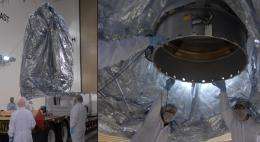NASA's WISE Mission Arrives at Launch Site

(PhysOrg.com) -- NASA's Wide-field Infrared Survey Explorer, or WISE, has arrived at its last stop on Earth -- Vandenberg Air Force Base, Calif.
WISE is scheduled to blast into space in December, aboard a United Launch Alliance Delta II rocket from NASA's Space Launch Complex 2. Orbiting around Earth, it will scan the entire sky at infrared wavelengths, unveiling hundreds of thousands of asteroids, and hundreds of millions of stars and galaxies.
The spacecraft arrived at Vandenberg along the central California coast today, after a winding journey via truck from Ball Aerospace & Technologies Corporation in Boulder, Colo. Ball built the mission's spacecraft; its telescope and science instrument were built by Space Dynamics Laboratory in Logan, Utah.
"WISE has arrived and is almost ready to go," said William Irace, the mission's project manager at NASA's Jet Propulsion Laboratory, Pasadena, Calif. "After we check the spacecraft out and fill the telescope cooling tanks with solid hydrogen, we'll mate it to the rocket and launch."
WISE is an infrared space telescope like two currently orbiting missions, NASA's Spitzer Space Telescope and the Herschel Space Observatory, a European Space Agency mission with important NASA participation. But, unlike these missions, WISE will survey the entire sky. It is designed to cast a wide net to catch all sorts of unseen cosmic treasures. Millions of images from the survey will serve as rough maps for other observatories, such as Spitzer and NASA's upcoming James Webb Space Telescope, guiding them to intriguing targets.
"WISE will survey the cosmic landscape in the infrared so that future telescopes can home in on the most interesting 'properties,'" said Edward Wright, the principal investigator for the mission at UCLA.
The infrared surveyor will pick up the heat from a cornucopia of objects, both near and far. It will find hundreds of thousands of new asteroids in our main asteroid belt, and hundreds of near-Earth objects, which are comets and asteroids with orbits that pass relatively close to Earth. The mission will uncover the coldest stars, called brown dwarfs, perhaps even one closer to us than our closest known neighbor, Proxima Centauri, which is 4 light-years away. More distant finds will include nurseries of stars, swirling planet-building disks and the universe's most luminous galaxies billions of light-years away.
The data will help answer fundamental questions about how solar systems and galaxies form, and will provide the astronomical community with mountains of data to mine.
"WISE will create a legacy that endures for decades," said Peter Eisenhardt, the mission's project scientist at JPL. "Today, we still refer to the catalogue of our predecessor, the Infrared Astronomical Satellite, which operated in 1983."
The Infrared Astronomical Satellite was a joint infrared survey mission between NASA, the United Kingdom and the Netherlands. WISE's survey, thanks to next-generation technology, will be hundreds of times more sensitive.
The mission will scan the sky from a sun-synchronous orbit, 500 kilometers (about 311 miles) above Earth. After a one-month checkout period, it will map the whole sky over a period of six months. Onboard frozen hydrogen, which will cool the infrared detectors, is expected to last several months longer, allowing WISE to map much of the sky a second time and see what has changed.
Provided by JPL/NASA (news : web)















